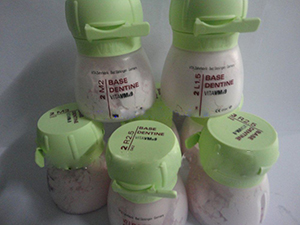1) High noble alloys (Precious metal)
This group has a composition that is over 60% noble metal (gold, palladium and/or platinum), of which more than 40% must be gold.
Examples of high noble dental alloys.
- Product: JRVT / Alloy Color: Yellow / Composition: 77% Gold, 13% Silver, 8.5% Copper, 1.0% Palladium, Less than 1% Indium, Iridium, Zinc
- Product: Noble-Cast 67 / Alloy Color: Yellow / Composition: 64.0% Gold, 23.4% Silver, 3.0% Palladium, 0.1% Platinum
- Product: Encore (White High Noble) / Alloy Color: Silver (white) / Composition: 48% Gold, 40% Palladium, 4.3% Zinc, 3.9% Tin, 3.75% Indium, 0.05% Rhenium
2) Noble alloys (Semiprecious metal)
These alloys have at least 25% noble metal content.
Examples of noble dental alloys.
- Product: Argenco 20 / Alloy Color: Yellow / Composition: 20% Gold, 20% Palladium, 40% Silver, 18% Indium, 2% Zinc, Less than 1% Iridium.
- Product: Argelite SR+ / Alloy Color: Silver (white) / Composition: 79% Palladium, 8.4% Tin, 5.0% Cobalt, 5.0% Gallium, 2.0% Gold, 0.6% Ruthenium
3) Non-noble (Nonprecious metal)
These alloys are also referred to as base metals. Their noble metal content is less than 25% (they may have none). They often contain large percentages of nickel, cobalt, chromium or beryllium.
Examples of non-precious (base) dental alloys.
- Product: Argeloy N.P. Supreme / Alloy Color: Silver (white) / Composition: 61% Cobalt, 27% Chromium, 6% Molybdenum, 5% Tungsten, 1% Silicon, Less than 1% Manganese, Iron, Carbon
- Product: Argeloy N.P. / Alloy Color: Silver (white) / Composition: 54.0% Nickel, 22.0% Chromium, 9.0% Molybdenum, 4.0% Iron, 4.0% Niobium, 4.0% Tantalum, 3.0 % Trace elements.











